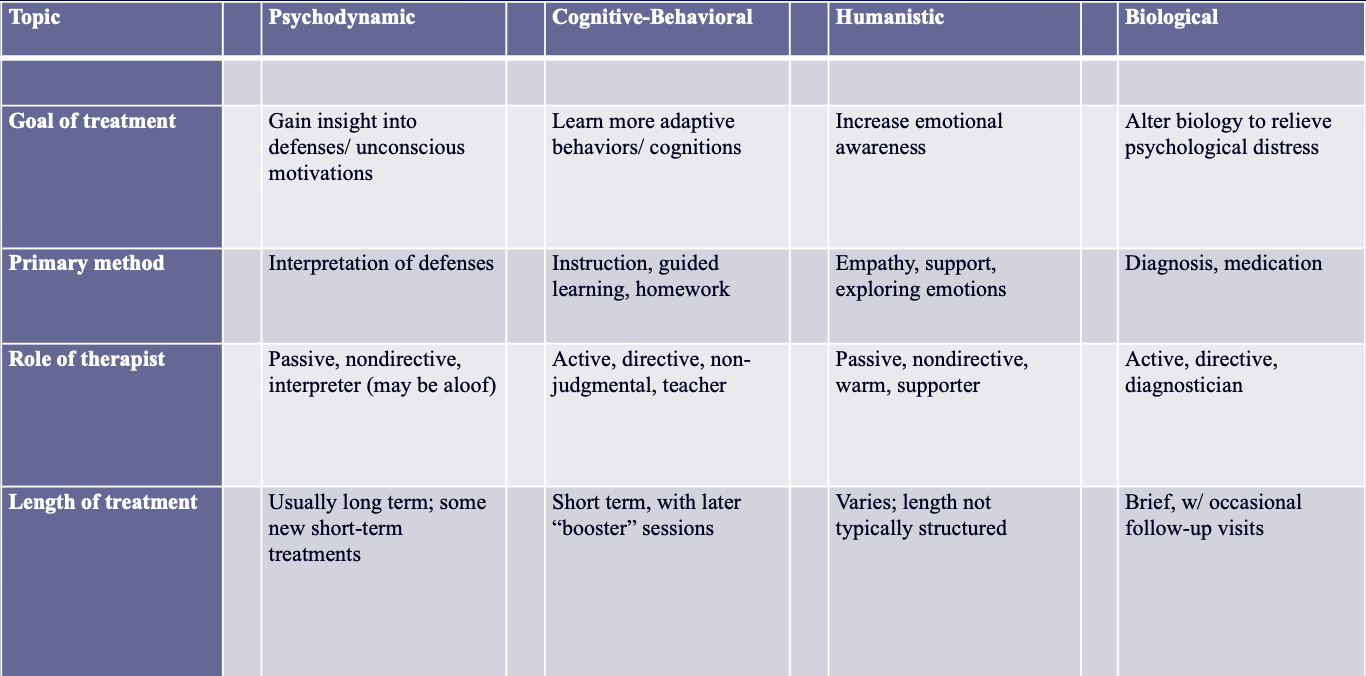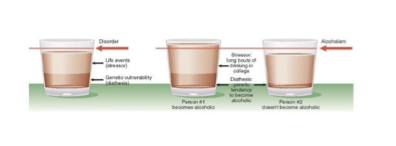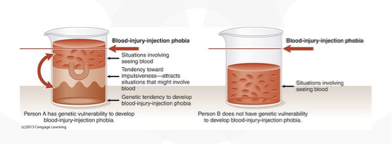PS371: Biological perspectives
1/37
There's no tags or description
Looks like no tags are added yet.
Name | Mastery | Learn | Test | Matching | Spaced |
|---|
No study sessions yet.
38 Terms
Genotype
genetic makeup from biological parents
Allele
one or two or more alternate forms of a gene that arise by mutation, found at same place on chromosome
each inherits two alleles from each of our biological parents
Phenotype
observable physical/behavioral characteristics
Heritability
proportion of variation between individuals in a given population (believed) due to genetic variation
Historical perspective
Disease model: each disorder has underlying cause, interpersonal and intrapersonal
Maladaptive behavioral trends internal conflicts
Reflects errors in personal development, each mental problem has underlying physiological cause (hormones, genetic defects)
Each one is unique
Emil Kraepelin
first formal system for classifying mental health disorders, published in textbook, physical diseases based
Assumption that each disorder had a different
Cluster of symptoms
Course
Age of onset
Cause
Genome-wide associated studies
identify specific genetic markers (single-nucleotide polymorphisms)
attempts to identify specific genetic variants, analyze risks for psychiatric disease, increase/decrease probability of disorders
Two primary models of GWAS
Common Disease / Common Variant (CDCV)
Multiple Rare Variant (MRV)
Example: Wray et al. (2013) on CDCV strategy
Evidence of genetic overlap between schizophrenia (Scz), bipolar disorder, major depression, attention deficit hyperactivity disorder, and autism?
Findings include that people w/ these disorders more likely to have suspect genetic variation at same 4 chromosomal sites, although overlap still relatively modest
Overlap in genetic variations highest between Scz & bipolar (15% heritability), intermediate for bipolar & depression (10%), lowest between Scz & autism (3%)
Genetic linkage analyses
examine unique traits with known genetic coding, traits viewed as potential markers for disorder (know about location)
ex. saccadic eye movement (schizophrenia)
rapid/simultaneous movement, outside of conscious awareness
relatives have difficulty in pursuit of fast moving objects
Twin/adoption/family studies
members demonstrate similarity in a variety of traits
twin: identical vs. fraternal similarities and differences analyzed
adoption: twins reared apart from biological parents, each other
family study method: expression of traits among relatives as a function of degree of relatedness
Gottesman (1991) … on Schizophrenia
Identical twins: 48% concordance
Fraternal twins: 17% concordance
Torrey et al. (1994)
Identical twins: 28% concordance
Fraternal twins: 6% concordance
How do they define identical/fraternal twinness?
General public prevalence of schizophrenia
~1%
Genetics summary
No individual genes lead to the expression of psychiatric disorder (contribute substantially)
Likely multi-genetic, more consistent with CDCV hypothesis
Risk influenced by psychological factors (not just genetic influence)
Evolutionary perspective
How long in human history has particular condition existed? (significance to the development and survival of a species)
How did people from far-flung cultures across time come up with similar explanations for abnormal behavior?
Might also ask:
What function does psychopathology serve? Any adaptive value?
Evidence of pathology across human history, or is it more recent?
Evidence that psychopathology qualitatively different from “normal”?
Factors associated with pathology protective?
World Health Organization on Schizophrenia
Remarkably similar across cultures
Comparable risk level
Not disappearing despite lower childbirth among people with Scz
Hindbrain
Brainstem
pons, medulla, cerebellum
Physiological arousal,
Control of posture, balance, movement
Midbrain
Brainstem
Reticular activating system
Arousal, experience of tension
Diencephalon
Brainstem
thalamus, hypothalamus
Behavioral and emotional regulation
Circuits that run from brain stem to cortical to subcortical structures
Basal ganglia
Sub-cortical
Caudate nucelus
Putamen
Globus pallidus
Limbic system
Sub-cortical
Amygdala
Hippocampus
Sub-cortical
relevant to complex motor behavior, memory, emotional expression, cognition, impulse control, sex, aggression, hunger, thirst
Cerebral cortex
>80% of all neurons in CNS
Left hemisphere: linguistic, analytic
Right hemisphere: spatial, holistic
Occipital
Processing/integration of visual input
Parietal
Touch recognition and body sensation
Temporal
Recognition of sights/sounds, aspects of language processing/expression, long-term memory storage
Frontal
Reasoning, planning, thinking / problem solving, moral / social judgment, aspects of memory, inhibition of inappropriate behavior, mental flexibility
Serotonin
at least 15 sites
Midbrain → higher cortical
Influence behavior, mood & thought
Low rates associated with reduced inhibition, impulsivity, tendency to overreact to various situations, aggression
Gamma aminobutyric acid
reduces post-synaptic activity
Inhibit wide range behavior, emotions
e.g., anger, hostility, aggression, even some positive emotional states such as eager anticipation and pleasure
best known effect = reduce anxiety
Norepinephrine
best known effects on arousal
Release increased by stress
Likely general behavioral regulator
Appears to influence mood and behavior
Dopamine
at least 5 sites
Associated with exploratory, outgoing, pleasure-seeking
Influences attention, mood, motivation
Key role in muscle movement
people with too little natural of this availability tend to engage in seeking activities, such as substance use or risky / exciting behavior (e.g., sky diving)
many major circuits merge with / cross major serotonin circuits
Psychotherapies
Cognitive-behavioral, psychodynamic models dominant perspectives
Real world interventions: many options
Individual … Couples … Family … Group … Self-Help
Most major conceptual frameworks well represented
Empirical support / validation is key
Early biological therapies
Except for primarily opium-based sedatives, little prior to 1930’s
1950’s … introduction of Neuroleptics (reserpine)
Drugs modify presence / effect of brain chemistry by increasing / decreasing the presence or effect of neurotransmitters
Contemporary drug therapy
primary mechanisms of action
Agonists: mimics action of NT at receptor sites, increasing NT’s effect
Antagonists: decreases / blocks action of NT at receptor sites, decreasing NT’s effect
Atypical: complex mechanisms of action / effect
Comparing treatment strategies

Diathesis-Stress model
Diathesis = physiological vulnerability
Inherit vulnerability for disorder
Risk for expression influenced by stress
Stress not constant … risk for expression of disorder relatively fluid
Contemporary models also allow for psychosocial diatheses

Reciprocal Gene-Environment model
more dynamic
Assumes that genetically-coded traits increase or decrease probability that we’ll encounter stressful experiences
